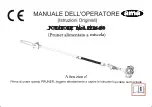
25
Fig. 36
Hole
Chain Catcher
Post
Bar Cover
Motor Housing
MAINTAINING THE SAW CHAIN
For safe, efficient operation, the saw chain must be maintained properly.
The saw chain will wear with use, causing the chain to stretch. This
is normal. When it is no longer possible to obtain a correct chain-
tension adjustment, the saw chain will need to be repaired by an
authorized service center or replaced. Refer to
Replacing the Guide
Bar and Saw Chain
.
Always keep the saw chain sharp. During operation, look for the
following indicators of a dull saw chain:
• Wood chips are small and powdery.
• The saw chain must be forced through the wood.
• The saw chain cuts to one side.
If any of these conditions exist, sharpen or replace the saw chain.
Refer to
Replacing the Guide Bar and Saw Chain
.
NOTE:
If you do not fully understand the process for properly
sharpening a saw chain, have the saw chain sharpened by an
authorized service center or replace the saw chain.
WARNING:
The saw chain is very sharp. Always wear
heavy-duty protective gloves when handling or performing
maintenance on the saw chain.
CAUTION:
A dull or improperly sharpened saw chain
can cause excessive motor speed during operation, which
can result in severe motor damage.
WARNING:
An improperly sharpened saw chain
increases the chance of kickback. Failure to replace or
properly maintain the saw chain can cause serious injury.
MAINTAINING THE GUIDE BAR
1. Rotate the guide bar frequently, at regular intervals (for example,
after every 5 hours of operation), to ensure even wear on the top
and bottom of the guide bar. Refer to
Removing and Installing
the Guide Bar and Saw Chain
.
2. Clean the guide bar groove and oil passages whenever the saw
chain is removed, when the unit has been used heavily or when
the saw chain appears dirty. Use a screwdriver, putty knife, wire
brush or similar instrument to remove debris from the guide bar
groove (Fig. 37). Use a small, soft wire to remove any debris
from the chain oil discharge hole (Fig. 38).
NOTE:
If the oil passages are clear, the saw chain will give off a
spray of oil shortly after it begins to rotate during operation.
3. Frequently check the guide bar for damage (Fig. 39). Feathering
and burring of the guide bar rails (the ridges on either side of the
bar groove) is a normal process of guide bar wear. Such faults
should be smoothed with a file as soon as they occur (Fig. 39). A
guide bar with the following faults should be replaced:
• Wear inside the guide bar rails that permits the chain to lay
sideways
• Bent guide bar
• Cracked or broken rails
• Spread rails
Refer to
Replacing the Guide Bar and Saw Chain
.
Fig. 37
Guide Bar Groove
Oil Passage
Fig. 39
Flat File
Uneven Wear
Bur
Spread Rails
Fig. 38
Chain Oil
Discharge Hole
Hole
Slot
Tab
Summary of Contents for RM1035P
Page 88: ......
















































